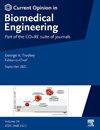Bioengineering gradients for controlled embryo and organ modeling
IF 4.2
3区 工程技术
Q2 ENGINEERING, BIOMEDICAL
引用次数: 0
Abstract
Symmetry breaking and tissue patterning are fundamental processes in mammalian development. Understanding these events is essential not only for advancing mammalian developmental biology but also for the ongoing efforts to create in vitro models of mammalian embryogenesis and organogenesis using stem cells. This review highlights recent bioengineering innovations designed to control exogenous and endogenous gradients of soluble biochemical signals and insoluble biophysical cues, effectively guiding cell differentiation and spatial organization in embryo and organ modeling. Specifically, we discuss microfluidics- and micropatterning-based multicellular culture systems, as well as approaches that use porous beads loaded with soluble factors and engineered cells as synthetic signaling centers to replicate dynamic in vivo signaling. We evaluate the effectiveness and limitations of each technique in influencing cell fate decisions, morphogenesis, and patterning, and explore their applications in modeling mammalian development. Finally, we outline emerging approaches that leverage bioengineered tools to construct mammalian embryo and organ models for both basic research and translational applications.
控制胚胎和器官建模的生物工程梯度
对称破坏和组织图案是哺乳动物发育的基本过程。了解这些事件不仅对推进哺乳动物发育生物学至关重要,而且对正在进行的利用干细胞建立哺乳动物胚胎发生和器官发生的体外模型也至关重要。本文综述了最近的生物工程创新,旨在控制外源性和内源性可溶性生化信号和不可溶性生物物理信号的梯度,有效地指导胚胎和器官建模中的细胞分化和空间组织。具体来说,我们讨论了基于微流体和微模式的多细胞培养系统,以及使用负载可溶性因子的多孔珠和工程细胞作为合成信号中心来复制动态体内信号的方法。我们评估了每种技术在影响细胞命运决定、形态发生和模式方面的有效性和局限性,并探索了它们在哺乳动物发育建模中的应用。最后,我们概述了利用生物工程工具构建哺乳动物胚胎和器官模型的新兴方法,用于基础研究和转化应用。
本文章由计算机程序翻译,如有差异,请以英文原文为准。
求助全文
约1分钟内获得全文
求助全文
来源期刊

Current Opinion in Biomedical Engineering
Medicine-Medicine (miscellaneous)
CiteScore
8.60
自引率
2.60%
发文量
59
 求助内容:
求助内容: 应助结果提醒方式:
应助结果提醒方式:


